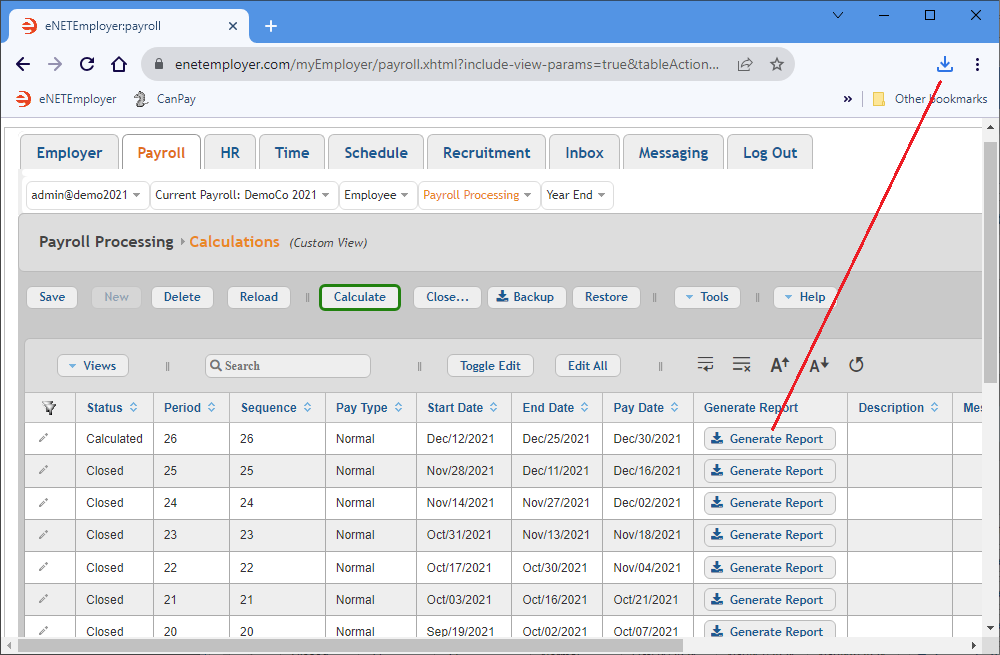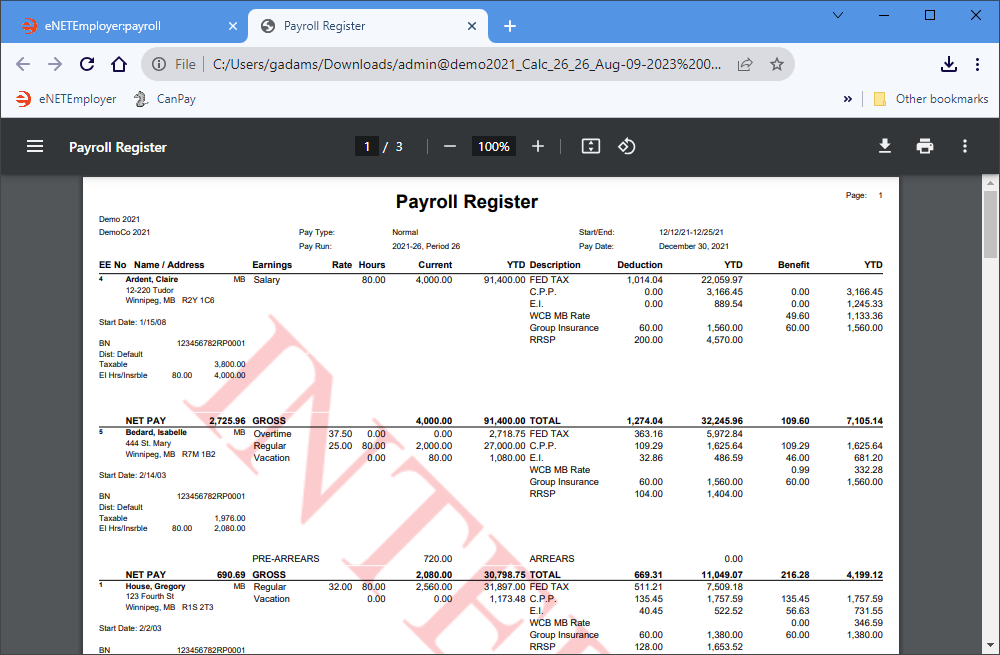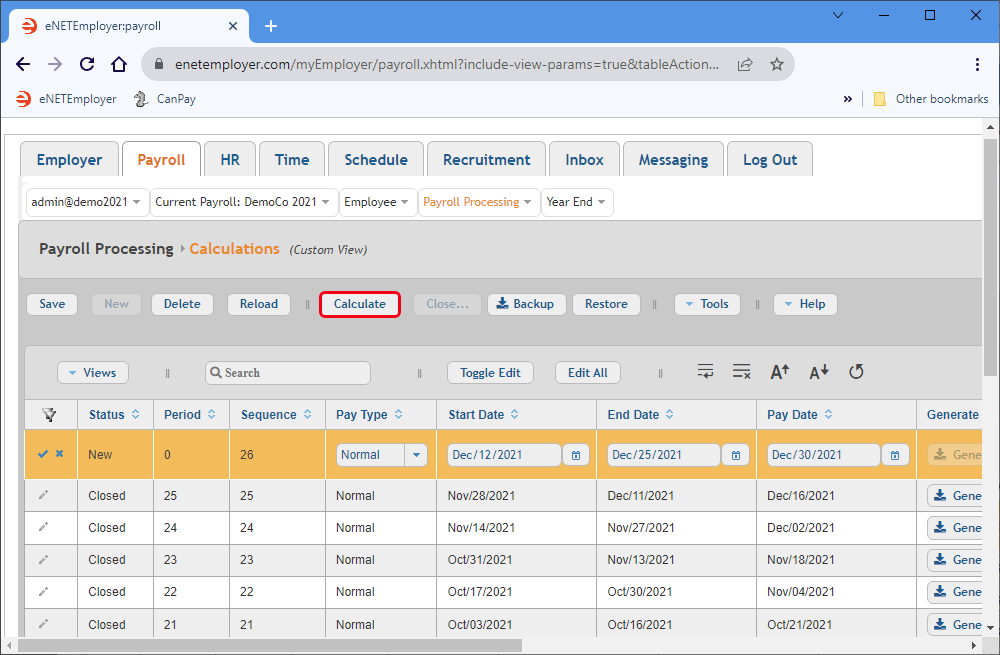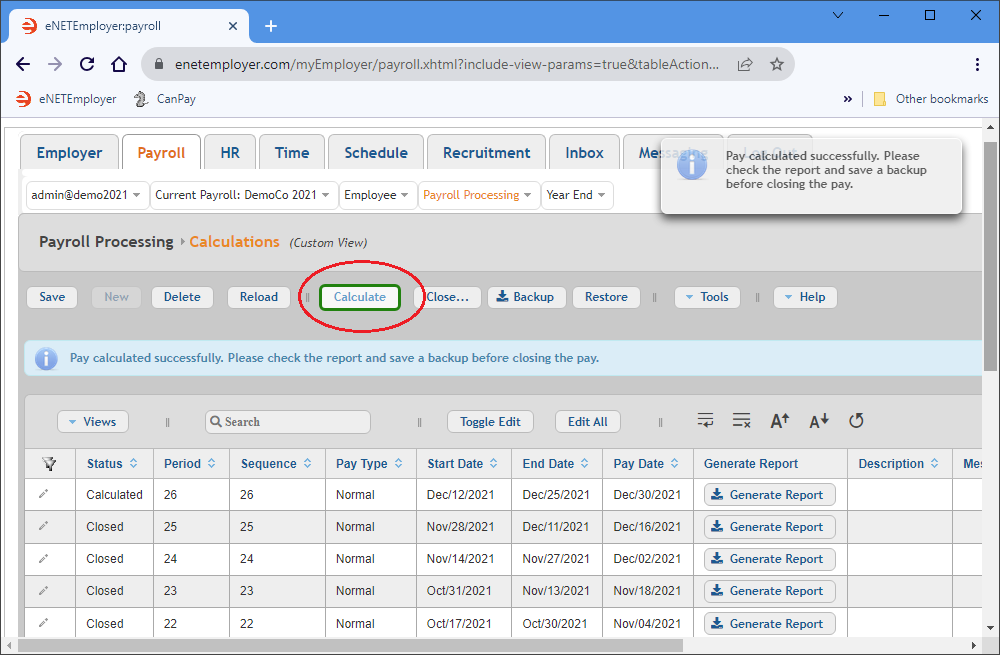Help Toolbar (select a button to browse other online help sections) Home Tutorials Resources Search Tabs & Menus Button Bar Table & Data Display |
Calculate and Review a Payroll
Each time you make a change to your payroll, you should perform a calculation. Each time the payroll is calculated, the results of the previous calculation are erased and replaced with the new results. A payroll may be calculated as many times as needed before it is closed. This provides the opportunity for reviewing the pay run details and for other testing purposes.
Each time you calculate, you should generate a new Payroll Register report and use it to verify your results. Repeat this step until the payroll register shows the expected results. This verification process is important because once a pay is closed, it cannot be re-calculated again. If you do find data entry errors or other issues after the pay had been closed, you would need to use either the Unclose or Restore procedures.
There are two parts to this tutorial:
- Step 1: Calculate your Payroll - How to calculate your payroll.
- Step 2: Review your Payroll - How to create a report so that you can review the results of your payroll calculations.
NOTE: Click on the images below to view them at full size
Part A) To Calculate Your Payroll
- From the Payroll tab, open the Payroll Processing - Calculations screen where you can define calculation settings and perform a calculation for the current payroll.
The table displays a list of previous calculations and includes pertinent data for each, such as the pay type along with the pay run's start and end dates. Each row in the table is known as a Pay Sequence and contains all of the necessary settings that the program needs to calculate the current pay period.
- First Time Program Users: If you are using a brand new payroll, the first pay sequence will already be inserted into the table for you. The pay run setting can now be changed as needed to suit the dates and parameters that suit your payroll scenario.
- Current Program Users (where historical payrolls already exist): If you are assuming the management of a current payroll where one or more closed pay sequences already exist, simply choose the New button from the Button Bar to add a new sequence to the table.
- Ensure that Edit Mode is activated for the current pay sequence row in the table (you can do so by double-clicking on the row or by choosing the Pencil icon to the left side of the row).
- Edit the various cells to suit the details of your pay run (press <F1> to use the Online Help system if you need to look up a definition for the various cells).
The mandatory items you will need to define for a typical payroll are:
- Pay Type - Use this cell to specify the calculation method that will be used.. Pay types can be any of the following; Normal, Additional, Extra, or Reversal (Special), or Reversal (All).
- Start Date - Use this cell to specify the beginning date of the current payroll run. This date represents the start of the current period in which employees worked or earned wages. For example, if your company is set up for semi-monthly payrolls (24 per year) and you are in the fourth week of January 2023 (having already ran your first payroll of the year), this cell would show Jan/16/2023 (i.e. the second semi-monthly pay run of the year begins on the 16th of January).
- End Date - Use this cell to specify the closing date of the current payroll run. For example, if your company is set up for semi-monthly payrolls (24 per year) and you are in the fourth week of January 2023 (having already ran your first payroll of the year), this cell would shows Jan/30/2023 (i.e. the second semi-monthly pay run of the year ends on the 30th of January).
- Pay Date - Use this cell to enter the actual date on which the employees receive their pay (e.g. cheques are distributed or EFT transactions occur) - commonly referred to as "Pay Day". This date is used to determine when payroll liabilities are due, based on deposit schedules. This date also is used to determine when any assigned tax calculation formulas may be applied.
The optional items you will need to define for a typical payroll are:
- Description - Use this cell to enter a description of the pay. This is an optional field used for administrative purposes only and does not appear on any reports. For example you can enter "First pay with new group insurance deduction" or any other pertinent text.
- Message - Use this cell to enter a message that you would like employees to see on their pay stubs. For example you can type "This pay run includes your annual bonus."
- Once your changes are complete, select the Save icon (the check mark icon at the left side of the row). This accepts the new settings and the Edit Mode icons are removed to indicate that the entire row has been saved. You can also choose the Save button from the Button Bar above the table.
After you save the row, you will notice how the Calculate button has a Red border around it. This indicates that a change has been made to the current pay data, and that the pay sequence should be recalculated before generating any new reports. - Choose the Calculate button from the Button Bar located above the table. Once the calculations are complete, a message will appear indicating the successful payroll calculation. Also, the Red border will be replaced by a Green border to signify that the payroll calculation includes your changes.
Calculating the first pay of the new year - Each time you calculate the first pay run of the new year, you must clear the year-to-date balances for your earnings, deductions, and benefit items from the previous year. You do so by placing a check in the Clear YTD Balance checkbox before you press the Calculate button. If you do not place a check in this box, the program will display a message when you attempt your first calculation of the new payroll year.
This checkbox is included as a safeguard to ensure that payroll administrators explicitly clear the previous year's balances before a new payroll is calculated in the new year. This checkbox can be used only when calculating the first pay of the new year. If you place a check in this box for any other pay run, an error message will be displayed and the payroll will not be calculated.
Note: Accumulators are not cleared when the Clear YTD Balance option is used. This is common for Vacation accumulators where the accumulated amounts must continue to accrue until they are disbursed. If your payroll contains an accumulator that should be cleared at the start of the year (e.g. unused Sick Time that expires at year end), you must do so manually by setting its value to zero in the Employee - YTD Accumulator Items screen.
Example: In our example below, it is the final sequence of the year and the pay type is set to Normal. Now that the payroll has been calculated, the Status cell updates to read Calculated. This cell will read Closed once the payroll is finalized and closed.
Now you can move the second part of this tutorial and learn how to review your payroll calculations.
Part B) To Review the Payroll Calculations
Once your payroll is calculated, you should view the Payroll Register report to verify your payroll calculation results.
- Choose the Generate Report button to create an interim Pay Register report as a .PDF document. Depending on your browser settings, the resulting document will either be stored in your Downloads folder or you may be presented with a window that will prompt you where to save the file. In most browsers, the document can be viewed via a link that appears at the top-right of your browser..
- Click the Download link to access the file, or navigate to your Downloads folder and open the document using your preferred PDF viewer. When the report appears on the screen, the word "Interim" appears as a watermark in the background. This watermark will be removed once you close the payroll and regenerate the report. As you scroll through the PDF document, you will see that each employee has been paid accordingly - both Salary and Hourly types. And once you reach the end of the employee list, the overall employee totals are shown. Scroll down further to the last page in the report and you will see the business accounts that are being used along with the Federal Tax, CPP and EI amounts.
- When you have finished reviewing your payroll results, close the report and return to eNETEmployer.


This completes the tutorial on how to calculate a payroll and to review its data.
See Also:

